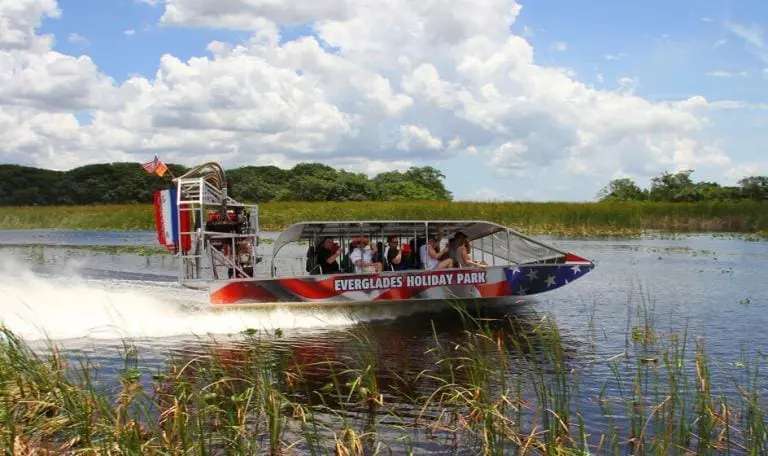
TOUR PACKAGES
A WILD ADVENTURE IN THE FLORIDA EVERGLADES
Buy Everglades Airboat Tours

60-Minute* Airboat Tours

Animal Encounters

Private Airboat Tours

60-MINUTE*
EVERGLADES AIRBOAT TOURS
Experience the unmatched sub-tropical Everglades ecosystem in one of our custom-built state-of-the-art airboats. Enjoy stunning views, wildlife sightings, and a thrilling adventure as our professional tour guides navigate you and your party through one of Florida’s most unique and intriguing landscapes. What’s more exciting? Every tour includes an exclusive live alligator show and 1 free professional grade group photo per party to remember your fun-filled day. Join us on a wild, Everglades adventure today!

EVERGLADES VIP TOUR
WITH ROUND-TRIP TRANSPORTATION
Explore the Everglades effortlessly. Let us handle the transportation to and from the park with our Everglades VIP Tour shuttle service—you handle the thrilling adventures, once-in-a-lifetime experiences, and up-close-and-personal explorations. Never again will you need to ask the question, “are there Everglades boat tours near me?” Whether you’re a Florida local or visiting us for the first time, we’ll proudly tackle the transportation details—just sit back, enjoy the Everglades adventure, and leave the driving to us.

PRIVATE
EVERGLADES AIRBOAT TOURS
Uncover the beauty of the Florida Everglades your way, at your own pace. Our professional tour guides can help you craft an entirely unique Everglades tour experience on your own private Everglades tour. Enjoy the beautiful wetlands at top-speeds for a heart-pumping adventure, or slow down to take in the scenery—either way, our knowledgeable tour guides are there to provide you with a fully narrated experience at your preferred pace.
Our custom-built airboats, designed and crafted right here at the park, boast twin automobile engines that generate ample gator power to send you soaring across the River of Grass. With a seating capacity of up to 25 passengers and over 25 boats in our fleet, we’re more than equipped to accommodate groups of any size, ensuring everyone can experience the magic of the Everglades together.
Planning a group outing, family reunion, or team-building event? Our group tours are perfect for large gatherings. We pride ourselves on our flexibility to cater to diverse groups and create a one-of-a-kind experience for all our guests.
Staying at a hotel or cruising into town and in need of transportation to the park? Worry not! We offer round-trip transportation services for our VIP airboat tours. Travel in style and comfort in one of our cozy vans or, for larger parties, hop aboard one of our spacious 32-passenger buses. No group is too big for an adventure at Everglades Holiday Park! So, gather your friends, family, or colleagues and get ready to embark on an extraordinary tour through the enchanting Everglades. Let the excitement begin!
At Everglades Holiday Park, we strive to provide our guests with an immersive experience that goes beyond the typical airboat ride. Our knowledgeable and experienced captains will guide you through the intricate network of waterways and swamps, sharing fascinating facts about the Everglades‘ unique ecosystem, diverse wildlife, and rich history. You’ll learn all about the park’s efforts to preserve and protect this invaluable treasure and the inhabitants of the Everglades.
Enjoy an action-packed airboat ride at our Everglades park where you will have a chance to meet the remarkable animals that call the Everglades home. You never know what you might see on our tours, from an iconic American alligator to the loved and endangered Florida panther, the breathtaking scenery and captivating wildlife provide countless photo opportunities – so remember your camera!
In addition to our thrilling tours, Everglades Holiday Park offers a variety of other exciting attractions for guests to enjoy. After your ride, be sure to catch our live alligator show, featuring the park’s world-famous Gator Boys Alligator Rescue Team. Witness these skilled professionals perform daring stunts and share their knowledge about these fascinating creatures, all while promoting conservation and educating the public on the importance of preserving the Everglades’ delicate ecosystem.
Looking for a more hands-on experience? Our Everglades animal encounters will get your family up close with some of the park’s most loved residents, including snakes, turtles, and baby alligators, all while under the supervision of our expert animal handlers. Enjoy a 45-minute opportunity to interact with these amazing wild animals and learn about their unique characteristics, habitats, and challenges they face in the wild.
To make your visit to Everglades Holiday Park even more memorable, we offer various amenities to ensure your comfort and convenience. Grab a bite to eat at our on-site café, where you’ll find a selection of delicious snacks and refreshments to satisfy your hunger after a day of adventure. Browse our gift shop for the perfect souvenir to commemorate your airboat tour experience, or pick up educational materials and unique gifts for friends and family back home.
We understand that accessibility is important for all our guests, and our Everglades Park is proud to offer wheelchair-accessible airboats and facilities. Our team is committed to accommodating the needs of every visitor and ensuring that everyone has the opportunity to explore the wonders of the Everglades.
We offer customizable experiences allowing you to choose the perfect tour duration, route, and level of adventure to suit your needs. For those seeking a more exclusive experience, consider our private tours, which provide an intimate and personalized journey through the Everglades just for you and your group.
Safety is our top priority at Everglades Holiday Park. Our fleet is meticulously maintained, and our skilled captains undergo rigorous training to ensure a secure and enjoyable experience for all guests. We provide life jackets and ear protection, and our team is always on hand to address any concerns or special requests you may have. Learn fun facts about airboats before you embark on your adventure tour.
Throughout the year, we host a variety of special events and seasonal activities at Everglades Holiday Park. From educational school and summer camp field trips to workplace celebrations and team-building, there is always something new and exciting happening at the park. Be sure to check our calendar of events and plan your visit accordingly to make the most of your Everglades adventure.
With so much to do in the Florida Everglades, it is no wonder our park is a top destination for visitors worldwide. Our tours offer an unparalleled opportunity to explore one of the planet’s most unique and fragile ecosystems, while our animal encounters and jon boat rentals ensure a fun and fulfilling experience for the entire family.
Ready to dive into the adventure of a lifetime? Book your airboat tour at Everglades Holiday Park today and discover the awe-inspiring beauty and captivating wildlife that make the Everglades a truly unforgettable destination. We can’t wait to share this incredible experience with you!
READY FOR YOUR EVERGLADES ADVENTURE?
Animal Encounters & Everglades VIP Tour Pick-up service:
Open 9:00 AM - 4:00 PM daily. Park hours are subject to unpredictable weather.
Park Info:
Open 9:00 AM - 4:00 PM daily. Park hours are subject to unpredictable weather.
BAIT & TACKLE AND GENERAL STORE HOURS:
7 Days a week: 7:00 AM – 7:00 PM Eastern Time
AIRBOAT TOURS & GATOR SHOW HOURS:
7 Days a Week: We open at 9:00 AM Eastern Time (rain or shine). *Tours are approximately 60-minutes long. Our last airboat tour departs promptly at 4:00 PM Eastern Time SHARP! Please arrive no later than 3:30 PM to receive the full tour experience.
PARK PRICING:
**All prices are subject to change without notice at our discretion. Please call our office directly for the most up-to-date pricing information.







